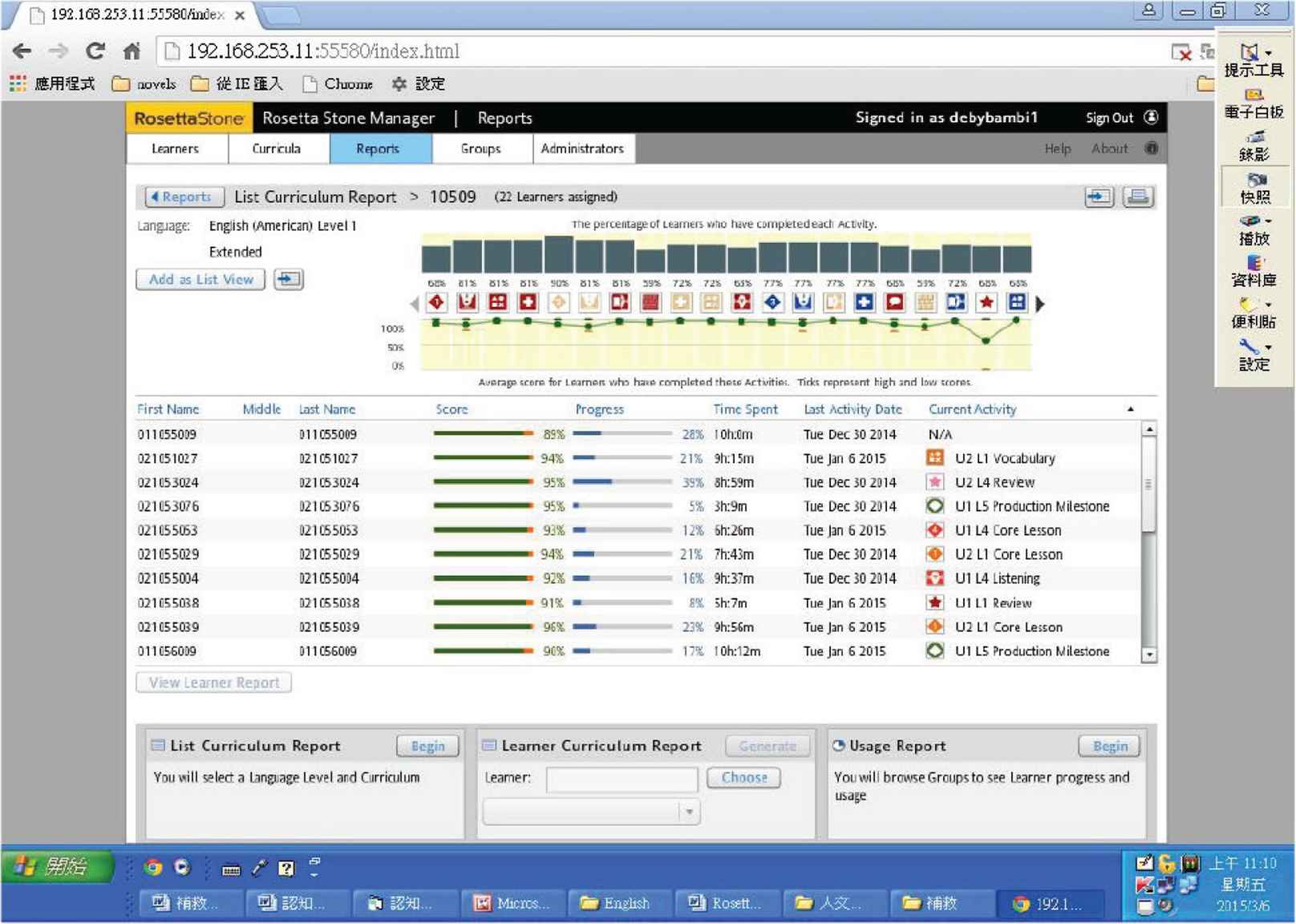A Study of Applying Computer-assisted Language Learning to English Course for Junior College Students in Taiwan
- DOI
- 10.2991/jrnal.k.200909.012How to use a DOI?
- Keywords
- Blended learning; computer-assisted language learning (Call); learning effectiveness; English course
- Abstract
This study aims to explore the impact of the integration of computer-assisted language learning into traditional face-to-face English course on the learning effectiveness at Junior college in Taiwan. To achieve the above purpose, this study adopts the pre-experimental design with one-group pretest–posttest design. This study adopts quantitative and qualitative methods for data analysis. The results indicated the application of English blended learning has positive and significant progress on students’ English learning effectiveness and learning motivation.
- Copyright
- © 2020 The Authors. Published by Atlantis Press B.V.
- Open Access
- This is an open access article distributed under the CC BY-NC 4.0 license (http://creativecommons.org/licenses/by-nc/4.0/).
1. INTRODUCTION
As education becomes a ubiquitous service through the global network, different education forms and models must be developed for better integration of the educational process. Blended learning integrates the advantages of traditional face-to-face course and Call, enters the mainstream course. From the perspective of course design, the blended course can be located anywhere between the fixed continuum at opposite ends through a fully face-to-face course and fully Call. So how to combine face-to-face course and Call? To better cater for this uncertain need of blended learning, the purpose of this study will discuss what may be the suitable balance of activities in English blended learning settings. And this study is also wonder whether the blended learning is really helpful to students’ learning effectiveness? Therefore, this study aims to explore the impact of the integration of Call into traditional face-to-face English course on the learning effectiveness at Junior college in Taiwan.
2. LITERATURE REVIEW
Learning in this century should not be constrained to the fence of a classroom, nor does it simply begin and end at an arranged hour. The development of information technology and the Internet, online learning has become a new emerging learning channel. The online learning has provided as alternative forms of education that has brought traditional in-class learning platforms offered in education out of the four walls of the classroom into the realm of cyberspace [1]. But the anecdotal evidence indicates that blended course instruction both offers more choices for content delivery and may be more effective than courses that are either fully online or fully classroom-based [2]. According to Garnham and Kaleta [3], blended learning is simply those in which a significant portion of the learning activities have been moved online, and time traditionally spent in the classroom is reduced but not eliminated.
The goal of blended courses is to join the best features of in-class teaching with the best features of online learning to promote active independent learning and reduce class seat time [3]. Blended courses offer the convenience and flexibility of wholly online courses without the complete loss of face-to-face contact, afford more student–teacher interaction, improved learning outcomes, increase student engagement, and expand access to educational offerings [4,5].
Osguthrope and Graham [6] asserted that blended learning must have an appropriate balance between online and face-to-face activities. Because of each student’s prior knowledge and learning pace are different, through the application of information technology and Internet, we can provide a customized learning model. And online learning has a number of learning management systems based on cloud applications that control learning activities and provide the individual course content.
While many of disciplines already offer online coursework, adding blended courses has the potential to meet the diverse learning needs of students and maximize available campus resources, especially in English learning. There are so many online English learning courses on the Web site. They can be used in Computer-assisted English learning system to motivate the students through interactive learning, and enhance student’s learning effectiveness by immediate online learning feedback.
3. RESEARCH METHODS
This study adopted the pre-experimental design with one-group pretest–posttest design.
3.1. Subject
There were one lecturer and 22 Junior college low achievement students as the subjects.
3.2. Research Materials
There was a step-by-step curriculum layout, which guided the students to arrange their own study schedule based on their own English proficiency.
3.3. Research Steps
The students would take the pretest in the beginning. Then the students experienced a 120 min per-week traditional face-to-face English courses for 18 weeks and finally took the posttest. The students had to report their learning journals to show their own progress every week. Finally, the posttest and a learning feedback questionnaire was conducted at the end of semester.
3.4. Data Analysis
The data were collected from pretest and posttest of English, the selection and compilation of Computer-assisted English learning resources, classroom observation logs, teacher’s interview, students’ online learning records, the percentage of progress. This study adopted quantitative and qualitative methods for data analysis. The SPSS statistical software package was used for quantitative analysis. First, descriptive statistics would be computed. Next, correlation and dependent sample t-test were calculated.
4. RESULTS
4.1. Pretest and Posttest
The results indicated that pretest score on the average (M = 45.09, SD = 12.463) was lower than the posttest score (M = 67.18, SD = 12.765). The posttest was higher than the pretest score. The correlation between the pretest and posttest of English score was 0.545 (p = 0.009, <0.05). It means the pretest and posttest of English score were significantly related.
Table 1 shows the mean between the pretest and posttest of English score was −22.091, t = −8.539 (df = 21, p = 0.000, <0.05). There were significant differences between the pretest and posttest English scores, and it means the posttest was significantly higher than the pretest.
| Paired differences | t | df | Sig. (two-tailed) | ||||||
|---|---|---|---|---|---|---|---|---|---|
| Mean | Std. deviation | Std. error mean | 95% confidence interval of the difference | ||||||
| Lower | Upper | ||||||||
| Pair 1 | Pretest and Posttest | −22.091 | 12.134 | 2.587 | −27.471 | −16.711 | −8.539 | 21 | 0.000 |
Paired sample t-test
4.2. The Percentage of Progress and Time Spent
Table 2 showed the correlation between the percentage of progress and the time students automatically spent on the Computer-assisted English learning course was 0.439 (p < 0.05). It means when the students automatically spent more time on the Computer-assisted English learning course, the more percentage of progress they made.
| Percentage of progress | Time spent in online course | |
|---|---|---|
| Percentage of progress | ||
| Pearson correlation | 1 | 0.439* |
| Sig. (two-tailed) | 0.041 | |
| N | 22 | 22 |
| Student time spent in online course | ||
| Pearson Correlation | 0.439* | 1 |
| Sig. (two-tailed) | 0.041 | |
| N | 22 | 22 |
Correlation is significant at the 0.05 level (two-tailed).
Correlation for percentage of progress and student time spent in online course
4.3. Learning Feedback Questionnaire
The following Table 3 are selected questions from surveys administered to students in the blended English courses at the end of 18 weeks (n = 22 for each question). To sum up, almost 80% students like the integration of face-to-face courses and Computer-assisted English learning into English courses, they feel that the instruction method is more interesting and helps them to learn English more effective.
| Agree (%) | Disagree (%) | Not opinion (%) | |
|---|---|---|---|
| I think the course is very interesting | 86 | 5 | 9 |
| I like to arrange the pace of my own learning | 81 | 9 | 10 |
| I like to know the immediate learning feedback | 77 | 9 | 14 |
| The course can stimulate my learning motivation | 81 | 5 | 14 |
| The time I spent online would better have been spent in class | 77 | 5 | 18 |
Learning feedback questionnaire
5. DISCUSSION
The results showed that the blended learning improved students’ English proficiency. The average posttest was significant higher than the pretest. And the more time students automatically spent on the Computer-assisted English learning course, the more progress they made. The application of Computer-assisted English learning system into traditional face-to-face course was positive and significantly effective. That is, the blended learning mode was efficient in English Learning.
5.1. Student
The blended learning combination of pedagogical methods seeks to encourage an active, engaged learning environment where students potentially learn more than in a traditional on-campus classroom [7]. Based on the questionnaire and students’ learning journal, it shows that blended learning do bring benefits to students. Overall, the blended learning shows that almost 80% students do view the new teaching method in a positive manner, they think the blended learning mode can stimulate their learning motivation, let them know the immediate learning feedback, and automatically spent more time on online learning. An important aspect of blended learning is that students should be able to learn independently and spend more time doing self-directed learning. And many students reported blended learning enhance them in self-directed learning and improve time management skills.
Garnham and Kaleta [3] found that the principle reason that 80% of the students gave high level of satisfaction was the time flexibility provided by the blended mode. Time flexibility is defined as the ability to control the pace of one’s learning, the convenience of scheduling coursework and a decrease in time spent in commuting. In this experiment, 81% students strongly agreed that one of the main benefits of blended learning was that they had more flexibility in their study time and they could arrange the pace of their own learning.
Spilka [8] noted that blended learning increases the opportunities for self-directed learning and develops project and time management skills. It means participating in a blended course requires students to be self-directed learners with effective time management skills. From students’ learning journal, many students reported blended learning enhance them in self-directed learning and improve time management skills.
But it is not generally common for Asian students. Prangpatanpon [9] reported there is a lack of self-directed learning activities among Thai students, because they are used to authoritarian practice, and are willing to accept what their teachers said without questioning. It is different from the result of Spilka’s experiment. In this case, Taiwanese students hope to have more flexible time and arrange their own learning progress.
However, a change from a face-to-face classroom to student-centered active learning can constitute a radical change for some students. If students who wish to take a traditional face-to-face study take a blended learning course, this form of learning may be disappointing and frustrating. Especially those students who are not used to being responsible for their own studies. So the student’ characteristics will influence their acceptance of blended learning mode, and their learning effectiveness. It may be a new direction for future research.
5.2. Teacher
From 18 classroom observation logs and three interviews with the lecturer, the study found blended instruction was a greater workload than face-to-face instruction. The lecturer indicated that she spent much more time on blended instruction and on individual communication than she had in any face-to-face instruction. In order for true blending learning to occur, the structure of the course must be carefully evaluated to determine which instructional objectives can best be met in an online environment and which are better suited to a traditional classroom environment [10]. Therefore, the blended course need to combine face-to-face course and Call course to enhance students’ learning effectiveness.
The lecture needs to redesign course, and to think about what may be the appropriate balance of activities in English learning settings. The lecturer indicated that the most important is need to take care how to select activities which objectives can be met via Call and those which will be enhanced in a traditional face-to-face format. And course redesign also need to require a review of instructional strategies and assessment modes as well as the limitations presented by the existing course management techniques and system.
The lecturer set the learning goal from all students’ English performance of last semester and pretest. Then she selected the appropriate textbooks, matched with the relevant Call course as English teaching resources. The lecturer was build an introduction and schedule of course on the Web site. Using Call course, the lecturer created a simple Web site of materials to be covered, then she created study sheets for the quizzes. The lecturer indicated those 22 students are low achievement of English, their grammars were so poor. So she decided to focus on strengthen their grammar with face-to-face course. Matching the Call course, to enhance students’ words, phonetic, natural pronunciation and communication. The Call course provided the step-by-step curriculum layout, visual learning and directly response through online images, vigorously develop the English learning effectiveness of students to listen, speak, read and write.
Using the system of Call course, the instructor had the flexibility to arrange the curriculum, exam type and difficulty levels, as shown in Figure 1. She could create exams from the test bank of the website. Through managing exam types, time and frequency, she could fully understand the students’ learning status. And the students could arrange their own study schedules based on their own English proficiency and tested themselves when they were ready.

Examination management on the Web site.
The instructor could clearly know the grades, percentage of progress, correct rate, spending time, and the learning schedule of each student from the Web site, as depicted in Figure 2. The students could view their own progress and grades anytime. Besides, the instructor could really grasp the extent of the progress of the student’s grades, and then modified the content and progress of the teaching. When some students had problems in certain area, the instructor could help them individually. A few students had difficulty with the technology, so the lecture walked them through the English course. Others blasted through with no problems at all.

The learning schedule and spending time of each student.
The instructor also indicated that she always worked alone because other colleagues were seemingly frightened by the new technology and refused to apply Computer-assisted learning to the courses. She coaxed into the teaching training, built the course and learned to use what had become one of her best teaching tools.
6. CONCLUSION
Entering Education 4.0, learning has become highly customized and individualized. The Call course used interactive approach as instruction method to enhance students’ learning effectiveness. Through the hyperlink and AI calculus analysis from the online education platform of big data, we can accurately meet the needs of students, create customized courses and textbooks, and provide students with personalized courses in language learning. Even we can analysis of the different needs and characteristics of online learning for various ethnic groups and provide appropriate feedback to different ethnic and non-native language learner.
Although the present study has yielded findings that have practical implications of blended course, but an important area for future research in the years to come will be in the refinement of approaches to the application of online course. Lecturers are the key point to mastering the integration of information technology and the Internet into instruction. The more humanized development of Internet technology, the lower of lecturer’s technological anxiety. Lecturers will be influenced by the habit of using the Internet to enhance the willingness and effectiveness of lectures to integrate Internet technology into instruction.
CONFLICTS OF INTEREST
The authors declare they have no conflicts of interest.
AUTHORS INTRODUCTION
Prof. Shu-Hua Huang
 She is an Associate Professor at the General Education Center, Air Force Institute of Technology in Taiwan since 1996. Her specialties are psychology and education. She got her Master’s degree in Psychology at Chung Yuan Christian University in Taiwan. She obtained her PhD at the Institute of Educational Entrepreneurship and Management in National University of Tainan in Taiwan. She is interested in the fields of curriculum and teaching, general education, military education, and cadets’ traits. She would like to share ideas and experiences with people who are interested in the same topics.
She is an Associate Professor at the General Education Center, Air Force Institute of Technology in Taiwan since 1996. Her specialties are psychology and education. She got her Master’s degree in Psychology at Chung Yuan Christian University in Taiwan. She obtained her PhD at the Institute of Educational Entrepreneurship and Management in National University of Tainan in Taiwan. She is interested in the fields of curriculum and teaching, general education, military education, and cadets’ traits. She would like to share ideas and experiences with people who are interested in the same topics.
Dr. I-Hsien Liu
 He is a reacher fellow in the Taiwan Information Security Center @ National Cheng Kung University (TWISC@NCKU) and Department of Electrical Engineering, National Cheng Kung University, Taiwan. He obtained his PhD in 2015 in Computer and Communication Engineering from the National Cheng Kung University. His research interests include Cloud security, Wireless Network, Group Communication and Reliable Transmission in Mobile ad hoc networks.
He is a reacher fellow in the Taiwan Information Security Center @ National Cheng Kung University (TWISC@NCKU) and Department of Electrical Engineering, National Cheng Kung University, Taiwan. He obtained his PhD in 2015 in Computer and Communication Engineering from the National Cheng Kung University. His research interests include Cloud security, Wireless Network, Group Communication and Reliable Transmission in Mobile ad hoc networks.
REFERENCES
Cite this article
TY - JOUR AU - Shu-Hua Huang AU - I-Hsien Liu PY - 2020 DA - 2020/09/15 TI - A Study of Applying Computer-assisted Language Learning to English Course for Junior College Students in Taiwan JO - Journal of Robotics, Networking and Artificial Life SP - 199 EP - 203 VL - 7 IS - 3 SN - 2352-6386 UR - https://doi.org/10.2991/jrnal.k.200909.012 DO - 10.2991/jrnal.k.200909.012 ID - Huang2020 ER -
